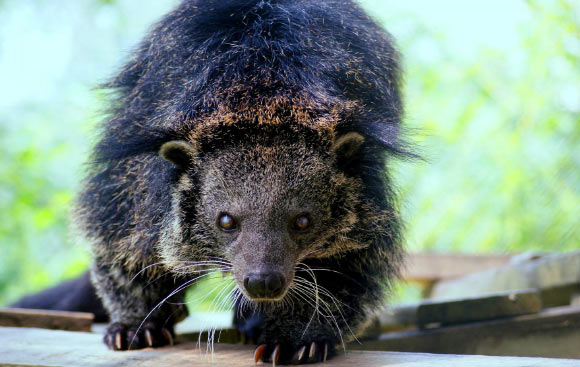A team of scientists led by Prof. Christine Drea of Duke University has identified a chemical compound that gives binturongs (Arctictis binturong) their characteristic scent.
The binturong, also known as bearcat, is a heavily built, robust civet with a fearsome appearance and is one of only two carnivores with a prehensile tail.
It is the largest species in the family Viverridae. It forms a distinct genus, with nine described subspecies which vary little in appearance.
Binturongs are widespread in south and Southeast Asia occurring in Bangladesh, Bhutan, Myanmar, China (Yunnan province), India, Indonesia, Lao PDR, Malaysia, Nepal, Philippines (Palawan), Thailand, and Viet Nam. Records from outside this range include a 1928 record from Guangxi, China, a record from Calauit Island, Philippines, and several from Cambodia.
The estimated average weight for the species ranges from 9 to 20 kg. The body length is 24 to 38 inches (60 to 96 cm). Females are around 20 percent larger than males.
Their hair coloration can vary from black to brown with white, silver, or rust on the tips, which gives these animals a grizzled appearance.
Binturongs are classed as carnivores but eat most anything that suits their fancy: mainly fruits, but also vegetables, birds, small mammals, and fish.
They are primarily nocturnal. During the day they generally sleep high in the forest canopy and love to bask in the Sun.
Many people who have met these creatures notice the same thing: they smell like hot buttered popcorn.
And for good reason — the chemical compound that gives freshly made popcorn its mouthwatering smell is also the major aroma emitted by binturong pee, according to Prof. Drea and co-authors.
In a paper appearing online in the journal Science of Nature, they analyzed urine samples collected during routine physical examinations of 33 binturongs at Carolina Tiger Rescue, a nonprofit wildlife sanctuary in Pittsboro, North Carolina.
Binturongs pee in a squatting position, soaking their feet and bushy tails in the process. They also drag their tails as they move about in the trees, leaving a scent trail on the branches and leaves behind them.
Using a technique called gas chromatography-mass spectrometry, the team identified 29 chemical compounds in the animals’ urine.
The one compound that emanated from every sample was 2-acetyl-1-pyrroline — the same compound that gives popcorn its tantalizing scent.
According to the scientists, male binturongs secrete more 2-acetyl-1-pyrroline than females.
“The fact that the compound was in every binturong we studied, and at relatively high concentrations, means it could be a signal that says, ‘A binturong was here,’ and whether it was male or female,” said study first author Lydia Greene, a graduate student at Duke University.
The compound 2-acetyl-1-pyrroline normally forms in popcorn during the popping process, when heat kicks off reactions between sugars and amino acids in the corn kernels. The same compound is also responsible for the comforting aromas of toasted bread and cooked rice.
“The question was: how do they do it? If you were to make this compound, you would have to use temperatures above what most animals can achieve physiologically,” Prof. Drea said.
“How does this animal make a cooking smell, but without cooking? It could be that binturong pee smells funny because of something they eat.”
Prof. Drea and her colleagues searched for 2-acetyl-1-pyrroline in the binturongs’ kibble, the one cooked item in their diet, but they didn’t detect any.
“A more likely explanation is that 2-acetyl-1-pyrroline is produced when binturong urine comes in contact with bacteria and other microorganisms that live on the animal’s skin or fur or in its gut,” the scientists said.
“Bacteria make smelly compounds as they break down sweat in our armpits in much the same way.”
“The time-release action of the microbes could help the binturongs’ urine smell-o-grams last long after the animals move on, an essential mode of communication for solitary animals that rarely encounter each other.”
_____
Lydia K. Greene et al. 2016. Reproductive endocrine patterns and volatile urinary compounds of Arctictis binturong: discovering why bearcats smell like popcorn. Science of Nature 103: 37; doi: 10.1007/s00114-016-1361-4








